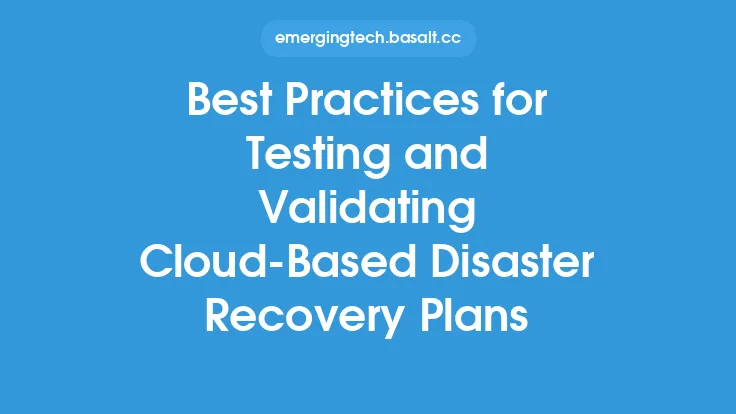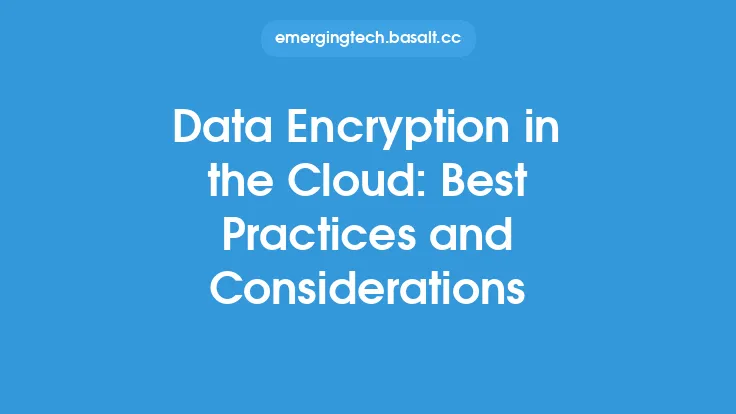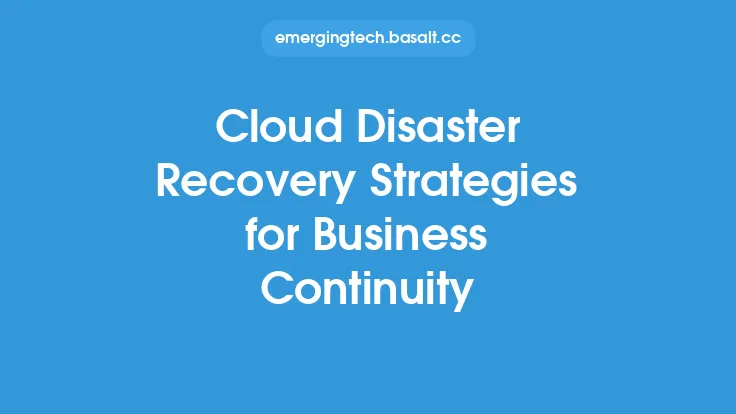Disaster recovery in cloud computing is a critical aspect of ensuring business continuity in the face of unforeseen events, such as natural disasters, cyberattacks, or equipment failures. Cloud computing provides a robust and scalable infrastructure for disaster recovery, enabling organizations to quickly recover from disruptions and minimize downtime. In this article, we will delve into the benefits and best practices of disaster recovery in cloud computing, exploring the technical and strategic aspects of this essential process.
Introduction to Disaster Recovery in Cloud Computing
Disaster recovery in cloud computing involves the use of cloud-based infrastructure and services to restore IT operations in the event of a disaster. This can include the replication of data, applications, and entire IT environments to a cloud-based platform, allowing organizations to quickly recover from disruptions and maintain business continuity. Cloud-based disaster recovery offers several advantages over traditional on-premises disaster recovery solutions, including reduced costs, increased scalability, and improved flexibility.
Benefits of Disaster Recovery in Cloud Computing
The benefits of disaster recovery in cloud computing are numerous and significant. Some of the key advantages include:
- Reduced costs: Cloud-based disaster recovery eliminates the need for organizations to maintain their own disaster recovery infrastructure, reducing capital and operational expenses.
- Increased scalability: Cloud computing resources can be quickly scaled up or down to meet changing disaster recovery needs, ensuring that organizations have access to the resources they need to recover from disruptions.
- Improved flexibility: Cloud-based disaster recovery solutions can be easily customized to meet the specific needs of an organization, providing a high degree of flexibility and adaptability.
- Enhanced reliability: Cloud computing providers typically offer high levels of redundancy and failover capabilities, ensuring that disaster recovery solutions are highly reliable and available.
- Faster recovery times: Cloud-based disaster recovery solutions can be designed to provide rapid recovery times, minimizing downtime and ensuring that organizations can quickly return to normal operations.
Key Components of Disaster Recovery in Cloud Computing
Several key components are involved in disaster recovery in cloud computing, including:
- Data replication: The process of replicating data to a cloud-based platform, ensuring that critical data is available in the event of a disaster.
- Application replication: The process of replicating applications to a cloud-based platform, ensuring that critical applications are available in the event of a disaster.
- IT environment replication: The process of replicating entire IT environments to a cloud-based platform, ensuring that all critical IT resources are available in the event of a disaster.
- Network connectivity: The establishment of network connectivity between the primary IT environment and the cloud-based disaster recovery platform, ensuring that data and applications can be quickly recovered in the event of a disaster.
- Security and compliance: The implementation of security and compliance measures to ensure that disaster recovery solutions meet regulatory and organizational requirements.
Best Practices for Disaster Recovery in Cloud Computing
Several best practices can be employed to ensure effective disaster recovery in cloud computing, including:
- Develop a comprehensive disaster recovery plan: Organizations should develop a comprehensive disaster recovery plan that outlines the steps to be taken in the event of a disaster, including the use of cloud-based disaster recovery solutions.
- Conduct regular backups and testing: Organizations should conduct regular backups of critical data and applications, and test disaster recovery solutions to ensure that they are functioning correctly.
- Implement automation and orchestration: Organizations should implement automation and orchestration tools to streamline disaster recovery processes, reducing the risk of human error and improving recovery times.
- Ensure security and compliance: Organizations should ensure that disaster recovery solutions meet regulatory and organizational security and compliance requirements, protecting sensitive data and applications.
- Monitor and analyze disaster recovery solutions: Organizations should continuously monitor and analyze disaster recovery solutions, identifying areas for improvement and optimizing disaster recovery processes.
Technical Considerations for Disaster Recovery in Cloud Computing
Several technical considerations are involved in disaster recovery in cloud computing, including:
- Cloud service provider selection: Organizations should carefully select a cloud service provider that meets their disaster recovery needs, considering factors such as scalability, reliability, and security.
- Cloud deployment model: Organizations should consider the cloud deployment model that best meets their disaster recovery needs, including public, private, and hybrid cloud models.
- Data replication and synchronization: Organizations should consider the data replication and synchronization methods that best meet their disaster recovery needs, including synchronous and asynchronous replication.
- Network connectivity and bandwidth: Organizations should consider the network connectivity and bandwidth requirements for disaster recovery, ensuring that data and applications can be quickly recovered in the event of a disaster.
- Security and encryption: Organizations should consider the security and encryption requirements for disaster recovery, protecting sensitive data and applications from unauthorized access.
Conclusion
Disaster recovery in cloud computing is a critical aspect of ensuring business continuity in the face of unforeseen events. By understanding the benefits and best practices of disaster recovery in cloud computing, organizations can develop effective disaster recovery solutions that meet their specific needs and requirements. Whether an organization is looking to reduce costs, increase scalability, or improve flexibility, cloud-based disaster recovery solutions can provide a robust and reliable means of recovering from disruptions and minimizing downtime. By following the best practices and technical considerations outlined in this article, organizations can ensure that their disaster recovery solutions are effective, efficient, and aligned with their overall business objectives.





